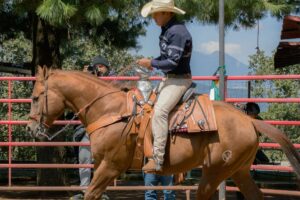
Saddle fitting plays a pivotal role in ensuring your horses comfort, overall well-being, and optimal performance. A well-fitted saddle provides proper weight distribution and allows freedom of movement, minimizing the risk of discomfort, pain, and potential long-term damage. In this article, we delve into the art of saddle fitting, discussing key factors to consider, common issues to watch out for, and expert tips to help you achieve the perfect fit for your equine companion.
Understanding the Importance of Saddle Fit: Achieving a proper saddle fit is crucial for both horse and rider. A well-fitted saddle prevents pressure points and soreness by evenly distributing the rider’s weight across the horse’s back. It allows the horse’s muscles to move freely, promoting natural movement and optimal performance. A poorly fitting saddle, on the other hand, can lead to discomfort, behavioral issues, and even back or muscle injuries.

Key Factors to Consider:
- Anatomy and Conformation: Every horse has a unique body shape and conformation, which significantly impact saddle fit. Factors such as wither height, back length, shoulder angle, and muscle development should be carefully evaluated when choosing a saddle.
- Saddle Tree: The saddle tree forms the foundation of the saddle. It should match the shape of your horse’s back, providing adequate clearance for the withers and spinal column. Choosing the right tree width and shape ensures a comfortable fit and allows the horse’s back to move freely.
- Panel Design: The panels of a saddle come into direct contact with the horse’s back. They should distribute weight evenly and conform to the contours of the horse’s back. Different panel designs cater to various conformation types, and consulting with a professional saddle fitter can help determine the best option for your horse.
- Gullet Clearance: Sufficient gullet clearance ensures that the saddle doesn’t place pressure on the horse’s spine. The width and shape of the gullet should accommodate your horse’s wither height and shape.
Common Saddle Fitting Issues:
- Bridging: Bridging occurs when the saddle fails to make full contact with the horse’s back, causing excessive pressure on certain areas. It often happens when the saddle’s tree is too straight for a horse with a more curvaceous back.
- Pinching and Pressure Points: Poorly fitted saddles can create pinching and pressure points, leading to discomfort and restricted movement. These points are typically found around the withers, shoulders, and along the horse’s spine.
- Imbalanced Weight Distribution: A saddle that is too narrow or too wide can result in uneven weight distribution. This can cause the saddle to tilt to one side, putting unnecessary strain on the horse’s back and potentially leading to muscle soreness or injury.

Tips for Achieving the Perfect Fit:
- Consult with a Professional: Engage the services of a qualified saddle fitter who can assess your horse’s conformation and recommend suitable saddle options. Their expertise can save you time and effort in finding the right fit.
- Regular Assessments: Horses’ bodies change over time due to factors like age, training, and fitness. It is essential to reassess saddle fit periodically to ensure it remains optimal for your horse’s evolving physique.
- Test Rides: Before committing to a saddle purchase, consider test riding it on your horse. This will give you a firsthand feel for its fit and comfort. Look for signs of relaxation, freedom of movement, and absence of pressure points.
- Seek Professional Adjustments: If you encounter saddle fitting issues or suspect your horse’s saddle needs adjustments, contact a qualified saddle fitter or a reputable saddle manufacturer for assistance. They can make necessary modifications to improve the fit.
Conclusion: Mastering the art of saddle fitting is crucial for the well-being and performance of your horse. By considering factors such as anatomy, saddle tree, panel design, and gullet clearance, you can ensure a comfortable and properly fitting saddle. Regular assessments, professional guidance, and timely adjustments will help maintain an ideal fit as your horse’s body changes. Prioritizing saddle fit not only enhances your horse’s comfort but also strengthens the bond and trust between horse and rider, fostering a harmonious partnership.






